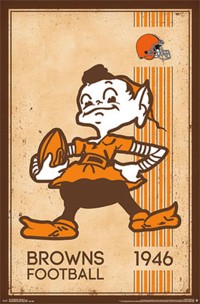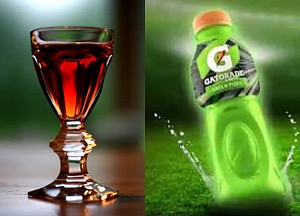FEBRUARY
27, 2015 ![]() THE
NEW ORANGE
THE
NEW ORANGE
The Cleveland Browns are being ridiculed again. This week, people have been joking about their announcement of a brand new logo (left) that’s only slightly different from their old one (right).
|
Notice the changes? The font is stronger, which is a definite improvement. Also, the helmet is a stronger color. It used to be orange. Now it’s red-orange, according to the Crayola terminology of my childhood box of 64 crayons. Or according to the red-green-blue terminology of my computer monitor, it used to be 244-101-35 and now it’s 255-61-0. That 255 is as high as the red component can get. |
|
Another detail: Because the team’s name is not the Red-Oranges but the Browns, they’ve painted the face mask brown. As though anyone will notice.
|
|
I’m ancient enough to remember the days of black and white, when Cleveland’s games were televised across Ohio. The Browns had a “brownie” mascot, and in the late 1950s their telecasts began with a few seconds of a cartoon featuring this good-natured little elf with the pointed floppy sacks on his feet. Presumably the film played on a projector back at the originating station while an announcer proclaimed something like “The Cleveland Browns are on the air!” There may have been a mention of a sponsor such as a Cleveland-brewed Carling beer. “Hey, Mabel! Black Label! And now let’s kick off the action!” The cute little animated brownie teed up his football, backed up a few steps, clenched his fists, stuck out his elbows, and came running towards us. Like Lou Groza, he kicked the football directly toward us, not soccer-style but a straight-ahead kick. The ball filled the screen, and at that moment the telecast cut to live video from the stadium. Ah, the good old days. |
|
To return to 2015, the Browns have made another logo update. The old Dawg (far right) appeared annoyed and determined, but the new version is mean and vicious and snarling and red-orange and possibly rabid. This illustrates a disturbing tendency to make sports logos as evil as possible. While the long-established St. Louis baseball team's logo is a robust but peaceful vegetarian cardinal (lower right) with a bill adapted for eating seeds, the University of Louisville’s redder redbird somehow has been given a raptor’s sharp beak and an angry Dawg’s snarling teeth. (What birds have teeth?) Even its toes are twisted in rage. We seem to need our sporting symbols to display a killer instinct of unbridled aggressiveness. |
|
That brings me to a recent quote from Stephen Hawking.
“The human failing I would most like to correct is aggression. It may have had survival advantage in caveman days, to get more food, territory or partner with whom to reproduce. But now it threatens to destroy us all. A major nuclear war would be the end of civilization, and maybe the end of the human race.
“The quality I would most like to magnify is empathy. It brings us together in a peaceful, loving state.”
|
|
Come
on, people, now. |
FEBRUARY
23, 2015 ![]() THE
MORNING AFTER
THE
MORNING AFTER
Most Oscar acceptance speeches used to be cut off by wrap-it-up music, and I used to think the orchestra waited too long. We don’t need to hear thirty seconds of the winner's self-conscious giggling and false modesty and hurried personal thanks to everyone from hairdresser to high school drama teacher.
But at the Academy Awards last night, many of the speeches had actual content, such as Patricia Arquette’s call for “equal rights for women of the United States of America!”
And then there was Graham Moore:
"Alan Turing never got to stand on a stage like this ... I do! And that's the most unfair thing I've ever heard.
"So in this brief time here, what I wanted to do was say this: When I was 16 years old, I tried to kill myself because I felt weird and I felt different, and I felt like I did not belong. And now I'm standing here.
“And so I would like this moment to be for this kid out there who feels like she's weird or she's different or she doesn't fit in anywhere. Yes, you do. I promise you do. Stay weird. Stay different.
“And then, when it's your turn and you are standing on this stage, please pass the same message to the next person who comes along!”
And finally there was Alejandro González Iñárritu:
“I want to dedicate this award for my fellow Mexicans, the ones who live in Mexico. I pray that we can find and build the government that we deserve.
“And the ones that live in this country, who are part of the latest generation of immigrants, I just pray that they can be treated with the same dignity and respect as the ones who came before and built this incredible immigrant nation.”
Let me also comment on the music. I’ve been out of touch. I haven’t really paid that much attention to popular music since the last time I worked on MTV’s Spring Break telecast nearly 30 years ago.
Nowadays I hear celebrity news about female singers like Beyonce, Rihanna, Miley Cyrus, Taylor Swift, Jessica Simpson, or Lady Gaga. Usually the news is something outrageous. Also, I get the impression that their performances are typically loud and aggressive and aimed at energetic young folks who like to dance. That description doesn’t include me, so I don’t listen.
However, my cable system has forty audio-only Music Choice channels, and one night I happened to stop on channel 420, “Love Songs.” I heard all six of the previously mentioned artists singing melodic tunes that I didn’t mind listening to. It turns out that they all have talent!
This was demonstrated last night when Lady Gaga amazed all of us with a medley from The Sound of Music.
Local movie reviewer Sean Collier tweeted, “In her most shocking move yet, Lady Gaga wears a normal dress and sings regular-type.” Piers Morgan commented, “This is, to my utter astonishment, fabulous.” And Patton Oswalt said, “Um... Lady Gaga is completely, unarguably, nailing it. Sorry; I know I’m supposed to be snarky. But that's what's happening.”
Also, last night’s Best Original Song came from the movie Selma. I’d heard the name John Legend but had never listened to him or Common perform, until their powerful rendition of “Glory.”
And the previous Sunday, during the Saturday Night Live celebration, the usually controversial Miley Cyrus covered Paul Simon’s 1975 hit “50 Ways to Leave Your Lover” with a smoky countrified rendition that I for one enjoyed. I also like Miley’s performance of “Jolene,” a 1973 hit written by her godmother Dolly Parton.
I need to listen more to the music today’s young people are making.
FEBRUARY
18, 2015 ![]() FEBRUARINESS
FEBRUARINESS
Here in Pittsburgh, we’re enduring a couple of weeks of snow and subzero temperatures. (At least we’re not in Boston!)
I worked a basketball telecast Saturday. Afterwards, during the four minutes it took to walk from the TV truck into the arena, snow blown by strong winds covered the front of my coat and ski mask. The same squall caused a white-out on a two-mile section of the Pennsylvania Turnpike, resulting in three pileups involving a total of 20 cars.
|
Back in 1979, my father (right) escaped that year's blizzard by temporarily relocating to sunny Arizona, as he and my mother did every February. But on the weekend I joined them, he and I went indoors to watch the Daytona 500 on television. That race was exactly 36 years ago today. I've recalled it in a new article on NASCAR's Perfect Storm. |
|
FEBRUARY
12, 2015 ![]() SUGGESTED
SOLUTION 4: SCREAM
SUGGESTED
SOLUTION 4: SCREAM
(If screaming fixed the trouble, leave a note for the chief engineer.)
When I was in college, dozens of us had two-hour weekly shifts at the student radio station. We were all brilliant scholars, of course, but we were amateur disk jockeys. Very few had ever encountered an audio control board. Each of us had to be helped through our first show, then given a refresher course when we returned the following week.
|
|
“Here in the control room, this is your microphone. Turn it on by pushing this switch to the right. The knob below it adjusts your volume. And this is how you cue up a record. But if it’s a 45 instead of a 33, you do it this way instead. When it’s time for the news, here’s how you play the theme, and the switch for the newscaster’s mic is over here, unless he’s in Studio D. Now if you’re working out of Studio B, everything’s different.” |
For situations when no experienced engineer was around, the station actually provided a user’s manual, half an inch thick.
|
I edited the 1968 edition, and this month’s 100 Moons article consists of excerpts from that handbook. |
For example, because classical music has great dynamic range and listeners turn up their volume to hear the quieter passages, the announcer’s voice should also be quieter. For popular music, however, everything including the announcer is always at maximum loudness.
Even back then, I was aware that professional broadcasters frequently changed stations. As a later sitcom put it, they must have “got kind of tired packing and unpacking, town to town and up and down the dial.” Or, as the late DJ Lee Baby Simms put it, “Forty years in the business. 25 markets. 36 stations. 41 jobs. Fired 25 times. I loved every minute of it.”
Each time a DJ arrived at a new station, he confronted an unfamiliar set of controls. I wondered what kind of training program he had to go through before being trusted to solo on this 747. But I guess after you’ve seen a few “boards,” you’ve seen them all.
That’s not true of every business. Yesterday, when I visited the doctor, there were three office workers trying to learn the health system’s new computer setup, plus three tech support people trying to teach them. I think it was the third day for the IT people. Why did it have to be so difficult? Couldn’t they simply convert their old database into the new format somehow?
Well, it turns out they had done that. But they also had to adapt to a new computer screen layout, with functions concealed within new menus and submenus. There was a lot of note-taking going on. Also, the system now demanded digital images of my insurance card, my driver’s license, my signature, and my face. And there were glitches. For some reason, entering “Thomas Thomas” took them to the top of the patient list (which is where I belong, of course), and they had to scroll all the way down through the alphabet.
My daily newspaper also has converted to a new computer system. Around Thanksgiving, they warned subscribers that Customer Service would be essentially unreachable for the entire month of December. It must have taken them most of January as well. Only this week did I finally receive my annual renewal bill for the year that will begin more than six weeks ago, on December 28, 2014.
Computers are great, but switching from one to another can be a real pain. That’s one reason I haven’t even considered migrating from Microsoft to Apple.
FEBRUARY
7, 2015 ![]() TOM
VISITS TOM'S BIRTHPLACE
TOM
VISITS TOM'S BIRTHPLACE
|
|
My latest article offers a glimpse of a historic little town in northern Ohio. I dined there with my family long ago. I’ve given this piece the northern-Italian title of Uno Scorcio di Milano. |
FEBRUARY
3, 2015 ![]() ONE-SIDED
COMMUNICATION
ONE-SIDED
COMMUNICATION
At
five o’clock the other afternoon, a waitress came up to me and
began talking about an unfortunate incident involving a little
boy. I couldn’t catch everything she was saying, as she was speaking loudly and urgently and
rapidly. Apparently this boy had become separated from his
parents. Gesturing to the far side of the restaurant, she told
me, “You can see the youngster sitting there,” or something
like that. “Ironically, he lives only a few blocks away.”
she was saying, as she was speaking loudly and urgently and
rapidly. Apparently this boy had become separated from his
parents. Gesturing to the far side of the restaurant, she told
me, “You can see the youngster sitting there,” or something
like that. “Ironically, he lives only a few blocks away.”
“Okay,” I said, “I guess I can give him a ride home.” She explained me a few more details about what had happened. “That’s too bad,” I remarked. She kept on talking. “Fine,” I said, “I’ll go over and introduce myself. What’s the boy’s name?” But she didn’t answer me. She kept on talking. “What is his name?” I repeated. The waitress told me her name! And then she went away!
“What is the boy’s name?” I called after her. No response. “What is his name?” I shouted to no one in particular, and no one in particular responded. I had a powerless feeling, as though I didn’t exist. All the other restaurant patrons were staring numbly at a television set, from which I heard other voices speaking about other things.
I got up and walked over to the big table on the other side of the room. There sat several adults and at least two kids who could have been the little lost boy. I asked whether somebody needed a ride home. There was no reaction. They were all glued to the big screen, where a weather report was now in progress. We were warned of sub-zero wind chills overnight.
That was when I awoke from my nap. I had, of course, fallen asleep with the television on.
JANUARY
28, 2015 ![]() SCIENCE
QUESTIONS
SCIENCE
QUESTIONS
“Mommy, you studied engineering. When I make a right turn on my bike, it leans to my right. When you make a right turn in your car, it leans to your left. What’s the difference?”


When your bike turns right, you keep your balance by leaning into the turn. Inertia is trying to keep you going straight and seems to be pushing you > this way, so you lean and let gravity pull you < that way. But I can't bank my car, because it has four wheels on the ground. I have no way to offset what people call centrifugal force. It’ll roll my car over onto its side if I take the corner too fast.
“Oh. Another thing: I was looking at pictures of airplanes with propellers. All the way back to the Wright Brothers, the first props had two blades. Then they had three blades, four blades, and now even more. The engineers must have figured out that more blades are more efficient, right?”




JANUARY
22, 2015 ![]() DON'T
BELIEVE WHAT YOU HEAR
DON'T
BELIEVE WHAT YOU HEAR
I keep hearing a radio commercial for a fancy local restaurant that has French pretensions. Sounds to me like they’re advertising their Winter Prefix dinner.
That’s nothing new; even the Bob Evans chain offers a “3-course dinner” from a table d'hôte menu. I don’t know about this $29.95 Winter Prefix, though. I think I’d prefer the Summer Suffix.
But I digress.
|
A company could be very successful selling and guaranteeing worthless products. The “Merchant of Nothing” explains how in this month’s 100 Moons article. |
JANUARY
16, 2015 ![]() THE
TIMES
THE
TIMES
’Tis the season to televise pucks and hoops. In my case in Pittsburgh, that means NHL hockey and college basketball.
One thing I like about hockey is that the game ends when it’s supposed to end. Unless an official blows a whistle, the action is nonstop. Substitutes enter while play continues. In the final minutes, a losing team can’t delay the inexorable countdown. The coach can call a single timeout for a 30-second discussion at the bench, but only after the official has already stopped play.
In college basketball, however, each team can interrupt the action by calling five timeouts. The teams often use all ten opportunities. Also, late in the game, the trailing team can stop the clock another ten times or so by fouling an opponent. There seems to be a whistle every 1.9 seconds. Last month, blogger Bob Smizik reported, “It took 14 minutes to play the final 34 seconds of the Pitt-St. Bonaventure game Saturday. There were no commercials during those 14 minutes.”
If the game goes into overtime, another five minutes is put on the clock. I think that’s longer than necessary, and three would suffice. (Five minutes used to be even more painful to watch before the NCAA adopted a shot clock in 1985. Back when I started, if a team got the lead in overtime and also got possession of the ball, they’d freeze it by standing there for the next four minutes until the trailing team was forced to foul.)
Alternatively, the rules could specify a target score to end the game.
Televised college games are generally scheduled at two-hour intervals: the 7:00 game is followed by a 9:00 game on the same channel. Sometimes that works out, but often the 7:00 game drags on and on until 9:14. For those interested in the 9:00 matchup, nobody gets to see the introductory segment we TV types have lovingly produced (which frustrates us) and nobody gets to see the first several minutes of action (which frustrates the fans). I often think games should be scheduled 2½ hours apart so there’s no overlap. However, that would create other problems, for the schools and for the network’s bottom line.
The bottom line is all-important, of course. I read in the papers that ESPN is cutting costs by televising some college basketball without actually being present at the game.
The network does send half a dozen cameras and a few microphones, and they hire some local people to operate them. (However, local people like me miss out on our usual assignments for graphics, switching, tape replays, and the like.) The network may send a sideline reporter. Everyone else works out of the home office in Bristol, Connecticut. The pictures from the various cameras are transmitted back to ESPN, where a producer and director cut between them.
Graphics, replays, and other elements are created in Connecticut. Viewers don’t care where that stuff originates, but they do assume that the announcers are actually witnessing the game in person. They’re not.
|
Instead of reporting from a cramped table at courtside, they’re in a cramped room in Bristol. An ESPN article illustrates the technique with this view of soccer announcers Adrian Healey and Taylor Twellman calling a game “off the tube.” The idea isn’t completely new. It's been used for narrating tennis matches and Formula One races and other lower-rated events that take place far away — for example, on a different continent. On a forum for sports journalists, several deplored the technique. “At some point, something will happen that bites the broadcaster in the butt for doing it this way. What if the coach is attacked by a fan off-camera? Or there's an earthquake?” (I suppose if a sideline reporter is actually on site, he can track down the story.) |
|
There was also this comment: When the play-by-play announcer and analyst are at the game, “There are things that happen, things you see, that happen out of camera range. For someone to think the quality of the broadcast is just as good, that's not possible.”
Why do it like this? Travel has become more expensive and video bandwidth has become cheaper. It costs more to send a dozen highly-paid people to a college town for a day than it costs to transmit half a dozen camera signals across the country for a few hours. The times are moving on. (As are the times required to play a game.)
UPDATE: I've learned that this technique is called REMI, for REMote Integration. But will it become the norm? Jim Ryan of our local technicians union in Pittsburgh, IBEW Local #5, guesses that it won't, not completely. He wrote in 2021:
We are now 14 months into the COVID-19 pandemic that saw a radical change in how television is made [including] freelance truck technicians working on a World Feed where social distancing is implemented as best as it can.
It seems as if the light at the end of the tunnel of this pandemic is near, but I don't think that that means we will return to pre-pandemic workflows.
In the sports freelance world, most people saw the REMI shifting the majority of the technicians and production personnel to a remote studio, leaving only the camera operators, utilities, video and possibly an audio 2 at the venue. This would have led to a drastic reduction of technicians needed, especially on the visiting feed.
Now, due to the scramble to get sports television going during the pandemic and more cloud-based workflows, it is believed that more technicians will be working at the venue while the production team will remain in their home city.
A main reason driving this is that building a control room is quite expensive, and just as expensive to keep up to date. Therefore, it seems more cost-effective to continue to use the trucks that are out there, but to have connectivity through the cloud which reduces signal latency. Hopefully this will be where sports broadcasting goes, to keep a more traditional Dual Feed along with the technicians that work on them.
JANUARY
11, 2015 ![]() MAGENTA
WORLD
MAGENTA
WORLD
|
|
When I watched him in my bedroom twenty years ago, Dave always appeared to be in the pink. And so did everyone else. In a new article, I explain the reason for this. It all started on The Day the Green Died. |
JANUARY
5, 2015 ![]() GOOGLE
ME
GOOGLE
ME
In the early days of Internet search engines, users vied to find a phrase that returned one and only one hit.
I’ve done it! If you take the last two words of my post from New Year’s Day (enclosed in quotes to specify that the words have to appear consecutively) and Google that phrase, you get a single result. I’m the only one in the world who’s ever put those words together!

JANUARY
3, 2015 ![]() HOW
ABOUT THE “TRILOBITES”?
HOW
ABOUT THE “TRILOBITES”?
A sports headline told me the “Panthers” are playing the “Cardinals” today.
Are the Pitt Panthers kicking off against the Louisville Cardinals in another of those bowls? Or are the Florida Panthers skating into the St. Louis Cardinals ballpark for another of those outdoor hockey games? No, this is the National Football League, so it’s the Carolina Panthers against the Arizona Cardinals.
We need more uniqueness among nicknames. “Coelacanths,” anybody?
JANUARY
1, 2015 ![]() FOUR-LETTER
MNEMONIC
FOUR-LETTER
MNEMONIC
|
As a landlubber, I've always had trouble remembering which side of a boat is port and which is starboard. And which side is marked by a red light and which by green? A little research, and the fact that Portugal produces a red wine called “port,” led to this suggestion.
Simply
group together the four-letter words
Contrast
them with the longer words |
|


















